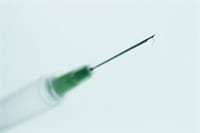No Drop Technique
The pros and cons of replacing
post-cataract
surgery drops with an injection of Kenalog and antibiotics.
JACQUELINE ZUMMO, MEDICAL
EDITOR
The postoperative cataract regimen of anti-infective and anti-inflammatory drops has, in some cases, been replaced with an injection of Kenalog and antibiotics. Ophthalmologists are using this new cutting-edge technique to treat patients who have undergone cataract surgery.

What are the main reasons why you have chosen to replace postop cataract drops with Kenalog?
Dr. Gills: First, it is difficult to get patients to use the drops and comply with the instructions they are given. Second, drops are catastrophic to the cornea and destroy tear channels.
Dr. Tipperman: The injections have revolutionized how retina vitreous specialists manage a variety of retinal problems, including macular edema. I think the biggest advantage injections have is for cataract patients and other anterior segment procedures because they can control postop inflammation.
Do you offer patients a choice between a Kenalog injection and drops?
Dr. Gills: Yes, but for the patients who have received Kenalog one time, they prefer it.
Dr. Tipperman: No. Intravitreal Kenalog injections are best for high-risk patients and I believe for routine patients, the current drop regimen that we use has a better safety profile. The problem is if the patient has a steroid rise related to the intravitreal Kenalog, you have put it in you cannot take it out, but if they are having a problem with their steroid drops, it is easy to discontinue and switch the drops.
What dose(s) of Kenalog do you find work best?
Dr. Gills: The dose I use varies. A 0.5 mg dose is effective and using more than 0.5 mg allows the Kenalog to last longer, and increases the duration of the effectiveness. One to 2 mgs works very well. At 2 mgs rarely do you need additional medicine. Myopia may require more than the 2 mg dose.
Dr. Tipperman: I use 0.1 ccs of the 0.4% concentration. When you inject the Kenalog, the second you see a flash of it in the vitreous that's actually enough, which is well under the 0.1 ccs.
In what part of the eye do you inject the Kenalog?
Dr. Gills: It really all depends upon the patient, but I inject Kenalog into, the zonules. Part of it goes into the vitreous and part of it lingers in the interior zonular area.
Dr. Tipperman: I take a needle down around what would be the anatomic portion of 6 o'clock in the eye, 3 mm back from the limbus. I put the needle in until I can see it through the pupil and then angle it posteriorily so the Kenalog is deposited as inferiorly as possible and the patient never sees it afterward.
How does this technique benefit patients?
Dr. Gills: Kenalog injections allow the doctor to spend less time explaining the use of drops and more time with the patient to answer other questions. The injections also shift the cost of postoperative care to the doctor, which is a small cost to the doctor and a large cost to the patient. This shift in cost buys annuity for your practice since it is greatly appreciated by the patient. There are no differences in coding and reimbursement for this technique and the staff loves it because they don't receive nearly as many phone calls after hours for prescription refills and instructions on how to use drops.
Dr. Tipperman: The injections have a higher potency and provide better treatment for significant macular problems. I use Kenalog in patients who are undergoing cataract surgery who have severe diabetic retinopathy or uveitis, or in patients who have been sent to me for a reoperation with complications or chronic cystoid macular edema. However, our current regimen using topical drops with anti-inflammatories works unbelievably well and has a very good safety profile for most patients.
Are there any drawbacks to this technique that are not seen with postop eye drops?
Dr. Gills: You must have excellent staff to give these injections. The drops are easier in a smaller practice or hospital where the level of sophistication is lower.
Dr. Tipperman: I personally know a number of patients who have received the injections who have needed bilateral tube shunts to be inserted for uncontrolled glaucoma.
James Gills, M.D., is founder and director of St. Luke's Cataract and Laser Institute in Tarpon Springs, Fla. Richard Tipperman, M.D., is active staff at Wills Eye Hospital in Philadelphia, Pa. Neither of the authors have any financial interest in the information contained in this article.








